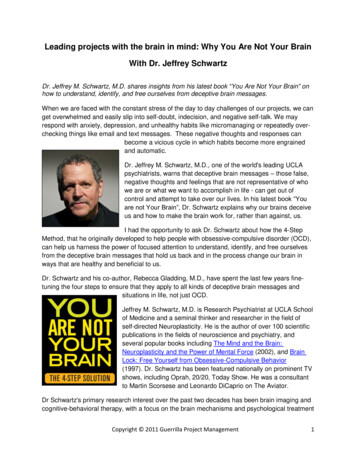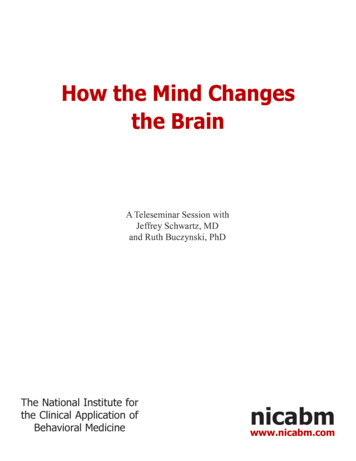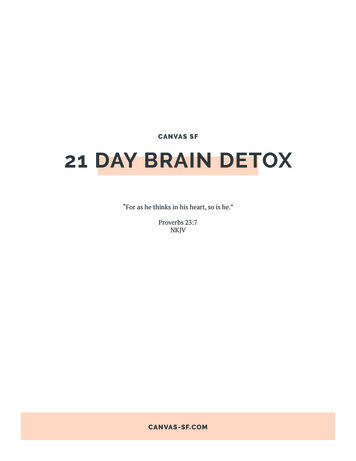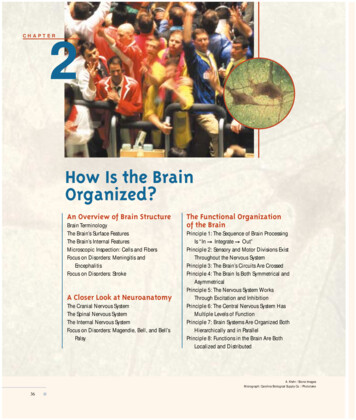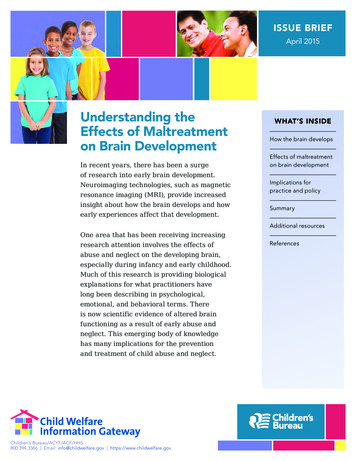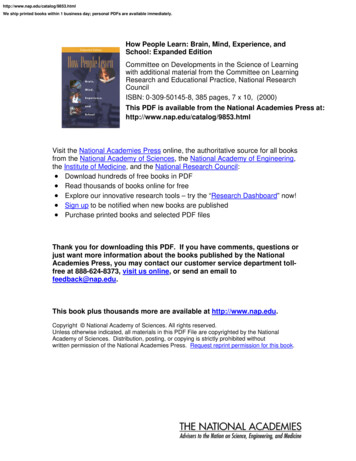
Transcription
http://www.nap.edu/catalog/9853.htmlWe ship printed books within 1 business day; personal PDFs are available immediately.How People Learn: Brain, Mind, Experience, andSchool: Expanded EditionCommittee on Developments in the Science of Learningwith additional material from the Committee on LearningResearch and Educational Practice, National ResearchCouncilISBN: 0-309-50145-8, 385 pages, 7 x 10, (2000)This PDF is available from the National Academies Press at:http://www.nap.edu/catalog/9853.htmlVisit the National Academies Press online, the authoritative source for all booksfrom the National Academy of Sciences, the National Academy of Engineering,the Institute of Medicine, and the National Research Council: Download hundreds of free books in PDF Read thousands of books online for free Explore our innovative research tools – try the “Research Dashboard” now! Sign up to be notified when new books are published Purchase printed books and selected PDF filesThank you for downloading this PDF. If you have comments, questions orjust want more information about the books published by the NationalAcademies Press, you may contact our customer service department tollfree at 888-624-8373, visit us online, or send an email tofeedback@nap.edu.This book plus thousands more are available at http://www.nap.edu.Copyright National Academy of Sciences. All rights reserved.Unless otherwise indicated, all materials in this PDF File are copyrighted by the NationalAcademy of Sciences. Distribution, posting, or copying is strictly prohibited withoutwritten permission of the National Academies Press. Request reprint permission for this book.
of Sciences. All rights reserved.
Expanded EditionHow People LearnBrain, Mind, Experience, and SchoolCommittee on Developments in the Science of LearningJohn D. Bransford, Ann L. Brown, and Rodney R. Cocking, editorswith additional material from theCommittee on Learning Research and Educational PracticeM. Suzanne Donovan, John D. Bransford, and James W. Pellegrino, editorsCommission on Behavioral and Social Sciences and Educationof Sciences. All rights reserved.National Research CouncilNATIONAL ACADEMY PRESSWashington, D.C.
NATIONAL ACADEMY PRESS 2101 Constitution Avenue N.W. Washington, D.C. 20418NOTICE: The project that is the subject of this report was approved by the Governing Board of the National Research Council, whose members are drawn from thecouncils of the National Academy of Sciences, the National Academy of Engineering,and the Institute of Medicine. The members of the committee responsible for thereport were chosen for their special competences and with regard for appropriatebalance.This study was supported by Grant No. R117U40001-94A between the National Academy of Sciences and the U.S. Department of Education. Any opinions, findings,conclusions, or recommendations expressed in this publication are those of theauthor(s) and do not necessarily reflect the view of the organizations or agenciesthat provided support for this project.Library of Congress Cataloging-in-Publication DataHow people learn : brain, mind, experience, and school / John D.Bransford . [et al.], editors ; Committee on Developments in theScience of Learning and Committee on Learning Research and EducationalPractice, Commission on Behavioral and Social Sciences and Education,National Research Council.— Expanded ed.p. cm.Includes bibliographical references and index.ISBN 0-309-07036-8 (pbk.)1. Learning, Psychology of. 2. Learning—Social aspects. I.Bransford, John. II. National Research Council (U.S.). Committee onDevelopments in the Science of Learning. III. National Research Council(U.S.). Committee on Learning Research and Educational Practice. IV.Title.LB1060 .H672 2000370.15’23—dc2100-010144Additional copies of this report are available from:National Academy Press2101 Constitution Avenue, N.W.Washington, D.C. 20418Call 800-624-6242 or 202-334-3313 (in the Washington Metropolitan Area).This volume is also available on line at http://www.nap.eduPrinted in the United States of AmericaCopyright 2000 by the National Academy of Sciences. All rights reserved.of Sciences. All rights reserved.
National Academy of SciencesNational Academy of EngineeringInstitute of MedicineNational Research CouncilThe National Academy of Sciences is a private, nonprofit, self-perpetuating societyof distinguished scholars engaged in scientific and engineering research, dedicatedto the furtherance of science and technology and to their use for the general welfare.Upon the authority of the charter granted to it by the Congress in 1863, the Academyhas a mandate that requires it to advise the federal government on scientific andtechnical matters. Dr. Bruce M. Alberts is president of the National Academy ofSciences.The National Academy of Engineering was established in 1964, under the charterof the National Academy of Sciences, as a parallel organization of outstanding engineers. It is autonomous in its administration and in the selection of its members,sharing with the National Academy of Sciences the responsibility for advising thefederal government. The National Academy of Engineering also sponsors engineering programs aimed at meeting national needs, encourages education and research,and recognizes the superior achievements of engineers. Dr. William A. Wulf is president of the National Academy of Engineering.The Institute of Medicine was established in 1970 by the National Academy ofSciences to secure the services of eminent members of appropriate professions in theexamination of policy matters pertaining to the health of the public. The Instituteacts under the responsibility given to the National Academy of Sciences by its congressional charter to be an adviser to the federal government and, upon its owninitiative, to identify issues of medical care, research, and education. Dr. Kenneth I.Shine is president of the Institute of Medicine.The National Research Council was organized by the National Academy of Sciences in 1916 to associate the broad community of science and technology with theAcademy’s purposes of furthering knowledge and advising the federal government.Functioning in accordance with general policies determined by the Academy, theCouncil has become the principal operating agency of both the National Academy ofSciences and the National Academy of Engineering in providing services to the government, the public, and the scientific and engineering communities. The Council isadministered jointly by both Academies and the Institute of Medicine. Dr. Bruce M.Alberts and Dr. William A. Wulf are chairman and vice chairman, respectively, of theNational Research Council.of Sciences. All rights reserved.
ivIn Memory ofAnn L. Brown(1943-1999)Scholar and ScientistChampion of Children and Those Who Teach ThemWhose Vision It Was toBring Learning Researchinto the Classroomof Sciences. All rights reserved.
vCOMMITTEE ON DEVELOPMENTS IN THESCIENCE OF LEARNINGJOHN D. BRANSFORD (Cochair), Learning Technology Center, VanderbiltUniversityANN L. BROWN (Cochair), Graduate School of Education, University ofCalifornia, BerkeleyJOHN R. ANDERSON, Department of Psychology, Carnegie Mellon UniversityROCHEL GELMAN, Department of Psychology, University of California, LosAngelesROBERT GLASER, Learning Research and Development Center, University ofPittsburghWILLIAM T. GREENOUGH, Department of Psychology and Beckman Institute,University of Illinois, UrbanaGLORIA LADSON-BILLINGS, Department of Curriculum and Instruction,University of Wisconsin, MadisonBARBARA M. MEANS, Education and Health Division, SRI International, MenloPark, CaliforniaJOSÉ P. MESTRE, Department of Physics and Astronomy, University ofMassachusetts, AmherstLINDA NATHAN, Boston Arts Academy, Boston, MassachusettsROY D. PEA, Center for Technology in Learning, SRI International, Menlo Park,CaliforniaPENELOPE L. PETERSON, School of Education and Social Policy, NorthwesternUniversityBARBARA ROGOFF, Department of Psychology, University of California, SantaCruzTHOMAS A. ROMBERG, National Center for Research in Mathematical SciencesEducation, University of Wisconsin, MadisonSAMUEL S. WINEBURG, College of Education, University of Washington,SeattleRODNEY R. COCKING, Study DirectorM. JANE PHILLIPS, Senior Project Assistantof Sciences. All rights reserved.
viCOMMITTEE ON LEARNING RESEARCH ANDEDUCATIONAL PRACTICEJOHN D. BRANSFORD (Cochair), Peabody College of Education and HumanDevelopment, Vanderbilt UniversityJAMES W. PELLEGRINO (Cochair), Peabody College of Education and HumanDevelopment, Vanderbilt UniversityDAVID BERLINER, Department of Education, Arizona State University, TempeMYRNA S. COONEY, Taft Middle School, Cedar Rapids, IAARTHUR EISENKRAFT, Bedford Public Schools, Bedford, NYHERBERT P. GINSBURG, Department of Human Development, TeachersCollege, Columbia UniversityPAUL D. GOREN, John D. and Catherine T. MacArthur Foundation, ChicagoJOSÉ P. MESTRE, Department of Physics and Astronomy, University ofMassachusetts, AmherstANNEMARIE S. PALINCSAR, School of Education, University of Michigan,Ann ArborROY PEA, SRI International, Menlo Park, CAM. SUZANNE DONOVAN, Study DirectorWENDELL GRANT, Senior Project Assistantof Sciences. All rights reserved.
viiPrefaceThis expanded edition of How People Learn is the result of the work oftwo committees of the Commission on Behavioral and Social Sciences andEducation of the National Research Council (NRC). The original volume,published in April 1999, was the product of a 2-year study conducted by theCommittee on Developments in the Science of Learning. Following its publication, a second NRC committee, the Committee on Learning Research andEducational Practice, was formed to carry that volume an essential step further by exploring the critical issue of how better to link the findings ofresearch on the science of learning to actual practice in the classroom. Theresults of that effort were captured in How People Learn: Bridging Researchand Practice, published in June 1999. The present volume draws on thatreport to expand on the findings, conclusions, and research agenda presented in the original volume.During the course of these efforts, a key contributor and one of the mosteloquent voices on the importance of applying the science of learning toclassroom practice was lost. The educational community mourns the deathof Ann L. Brown, Graduate School of Education, University of California atBerkeley, cochair of the Committee on Developments in the Science of Learning and an editor of How People Learn. Her insight and dedication to improving education through science will be sorely missed.of Sciences. All rights reserved.John D. Bransford, CochairCommittee on Developments in the Science of LearningCommittee on Learning Research and Educational Practice
of Sciences. All rights reserved.
ixContentsPart IIntroduction1 Learning: From Speculation to Science3Part IILearners and Learning2345How Experts Differ from NovicesLearning and TransferHow Children LearnMind and Brain315179114Part IIITeachers and Teaching6 The Design of Learning Environments1317 Effective Teaching: Examples in History, Mathematics,and Science1558 Teacher Learning1909 Technology to Support Learning206of Sciences. All rights reserved.
xCONTENTSPart IVFuture Directions for theScience of Learning10 Conclusions11 Next Steps for Research233248References285Biographical Sketches of Committees’ Members and Staff349Acknowledgments358Index363of Sciences. All rights reserved.
of Sciences. All rights reserved.IINTRODUCTION
of Sciences. All rights reserved.
LEARNING: FROM SPECULATION TO SCIENCE1Learning:From Speculation to ScienceThe essence of matter, the origins of the universe, the nature of thehuman mind—these are the profound questions that have engaged thinkersthrough the centuries. Until quite recently, understanding the mind—andthe thinking and learning that the mind makes possible—has remained anelusive quest, in part because of a lack of powerful research tools. Today,the world is in the midst of an extraordinary outpouring of scientific workon the mind and brain, on the processes of thinking and learning, on theneural processes that occur during thought and learning, and on the development of competence.The revolution in the study of the mind that has occurred in the lastthree or four decades has important implications for education. As we illustrate, a new theory of learning is coming into focus that leads to very different approaches to the design of curriculum, teaching, and assessment thanthose often found in schools today. Equally important, the growth of interdisciplinary inquiries and new kinds of scientific collaborations have begunto make the path from basic research to educational practice somewhatmore visible, if not yet easy to travel. Thirty years ago, educators paid littleattention to the work of cognitive scientists, and researchers in the nascentfield of cognitive science worked far removed from classrooms. Today,cognitive researchers are spending more time working with teachers, testingand refining their theories in real classrooms where they can see how different settings and classroom interactions influence applications of theirtheories.What is perhaps currently most striking is the variety of research approaches and techniques that have been developed and ways in which evidence from many different branches of science are beginning to converge.The story we can now tell about learning is far richer than ever before, andit promises to evolve dramatically in the next generation. For example:of Sciences. All rights reserved.3
4HOW PEOPLE LEARN, EXPANDED EDITION Research from cognitive psychology has increased understanding ofthe nature of competent performance and the principles of knowledge organization that underlie people’s abilities to solve problems in a wide varietyof areas, including mathematics, science, literature, social studies, and history. Developmental researchers have shown that young children understand a great deal about basic principles of biology and physical causality,about number, narrative, and personal intent, and that these capabilitiesmake it possible to create innovative curricula that introduce important concepts for advanced reasoning at early ages. Research on learning and transfer has uncovered important principlesfor structuring learning experiences that enable people to use what theyhave learned in new settings. Work in social psychology, cognitive psychology, and anthropologyis making clear that all learning takes place in settings that have particularsets of cultural and social norms and expectations and that these settingsinfluence learning and transfer in powerful ways. Neuroscience is beginning to provide evidence for many principlesof learning that have emerged from laboratory research, and it is showinghow learning changes the physical structure of the brain and, with it, thefunctional organization of the brain. Collaborative studies of the design and evaluation of learning environments, among cognitive and developmental psychologists and educators, are yielding new knowledge about the nature of learning and teachingas it takes place in a variety of settings. In addition, researchers are discovering ways to learn from the “wisdom of practice” that comes from successful teachers who can share their expertise. Emerging technologies are leading to the development of many newopportunities to guide and enhance learning that were unimagined even afew years ago.All of these developments in the study of learning have led to an era of newrelevance of science to practice. In short, investment in basic research ispaying off in practical applications. These developments in understandingof how humans learn have particular significance in light of changes in whatis expected of the nation’s educational systems.In the early part of the twentieth century, education focused on theacquisition of literacy skills: simple reading, writing, and calculating. It wasnot the general rule for educational systems to train people to think and readcritically, to express themselves clearly and persuasively, to solve complexproblems in science and mathematics. Now, at the end of the century, theseaspects of high literacy are required of almost everyone in order to successfully negotiate the complexities of contemporary life. The skill demands forof Sciences. All rights reserved.
LEARNING: FROM SPECULATION TO SCIENCEwork have increased dramatically, as has the need for organizations andworkers to change in response to competitive workplace pressures. Thoughtful participation in the democratic process has also become increasinglycomplicated as the locus of attention has shifted from local to national andglobal concerns.Above all, information and knowledge are growing at a far more rapidrate than ever before in the history of humankind. As Nobel laureate HerbertSimon wisely stated, the meaning of “knowing” has shifted from being ableto remember and repeat information to being able to find and use it (Simon,1996). More than ever, the sheer magnitude of human knowledge rendersits coverage by education an impossibility; rather, the goal of education isbetter conceived as helping students develop the intellectual tools and learningstrategies needed to acquire the knowledge that allows people to thinkproductively about history, science and technology, social phenomena, mathematics, and the arts. Fundamental understanding about subjects, includinghow to frame and ask meaningful questions about various subject areas,contributes to individuals’ more basic understanding of principles of learning that can assist them in becoming self-sustaining, lifelong learners.FOCUS: PEOPLE, SCHOOLS, AND THEPOTENTIAL TO LEARNThe scientific literatures on cognition, learning, development, culture,and brain are voluminous. Three organizing decisions, made fairly early inthe work of the committee, provided the framework for our study and arereflected in the contents of this book. First, we focus primarily on research on human learning (though thestudy of animal learning provides important collateral information), including new developments from neuroscience. Second, we focus especially on learning research that has implications for the design of formal instructional environments, primarily preschools,kindergarten through high schools (K-12), and colleges. Third, and related to the second point, we focus on research thathelps explore the possibility of helping all individuals achieve their fullestpotential.New ideas about ways to facilitate learning—and about who is mostcapable of learning—can powerfully affect the quality of people’s lives. Atdifferent points in history, scholars have worried that formal educationalenvironments have been better at selecting talent than developing it (see,e.g., Bloom, 1964). Many people who had difficulty in school might haveprospered if the new ideas about effective instructional practices had beenavailable. Furthermore, given new instructional practices, even those whoof Sciences. All rights reserved.5
6HOW PEOPLE LEARN, EXPANDED EDITIONdid well in traditional educational environments might have developed skills,knowledge, and attitudes that would have significantly enhanced their achievements.Learning research suggests that there are new ways to introduce students to traditional subjects, such as mathematics, science, history and literature, and that these new approaches make it possible for the majority ofindividuals to develop a deep understanding of important subject matter.This committee is especially interested in theories and data that are relevantto the development of new ways to introduce students to such traditionalsubjects as mathematics, science, history, and literature. There is hope thatnew approaches can make it possible for a majority of individuals to develop a moderate to deep understanding of important subjects.DEVELOPMENT OF THE SCIENCE OF LEARNINGThis report builds on research that began in the latter part of the nineteenth century—the time in history at which systematic attempts were madeto study the human mind through scientific methods. Before then, suchstudy was the province of philosophy and theology. Some of the mostinfluential early work was done in Leipzig in the laboratory of WilhelmWundt, who with his colleagues tried to subject human consciousness toprecise analysis—mainly by asking subjects to reflect on their thought processes through introspection.By the turn of the century, a new school of behaviorism was emerging.In reaction to the subjectivity inherent in introspection, behaviorists heldthat the scientific study of psychology must restrict itself to the study ofobservable behaviors and the stimulus conditions that control them. Anextremely influential article, published by John B. Watson in 1913, providesa glimpse of the behaviorist credo:. . . all schools of psychology except that of behaviorism claim that “consciousness” is the subject-matter of psychology. Behaviorism, on the contrary, holds that the subject matter of human psychology is the behavior oractivities of the human being. Behaviorism claims that “consciousness” isneither a definable nor a useable concept; that it is merely another word forthe “soul” of more ancient times. The old psychology is thus dominated bya kind of subtle religious philosophy (p. 1).Drawing on the empiricist tradition, behaviorists conceptualized learning asa process of forming connections between stimuli and responses. Motivation to learn was assumed to be driven primarily by drives, such as hunger,and the availability of external forces, such as rewards and punishments(e.g., Thorndike, 1913; Skinner, 1950).In a classic behaviorist study by Edward L. Thorndike (1913), hungrycats had to learn to pull a string hanging in a “puzzle box” in order for aof Sciences. All rights reserved.
LEARNING: FROM SPECULATION TO SCIENCEdoor to open that let them escape and get food. What was involved inlearning to escape in this manner? Thorndike concluded that the cats didnot think about how to escape and then do it; instead, they engaged in trialand-error behavior; see Box 1.1. Sometimes a cat in the puzzle box accidentally pulled the strings while playing and the door opened, allowing the catto escape. But this event did not appear to produce an insight on the part ofBOX 1.1A Cat’s Learning“When put into the box, the cat would show evident signs of discomfort andimpulse to escape from confinement. It tries to squeeze through any opening; itclaws and bites at the wire; it thrusts its paws out through any opening and clawsat everything it reaches. . . . It does not pay very much attention to the foodoutside but seems simply to strive instinctively to escape from confinement. . . .The cat that is clawing all over the box in her impulsive struggle will probably clawthe string or loop or button so as to open the door. And gradually all the otherunsuccessful impulses will be stamped out and the particular impulse leading tothe successful act will be stamped in by the resulting pleasure, until, after manytrials, the cat will, when put in the box, immediately claw the button or loop in adefinite way” (Thorndike, 1913:13).of Sciences. All rights reserved.7
8HOW PEOPLE LEARN, EXPANDED EDITIONthe cat because, when placed in the puzzle box again, the cat did not immediately pull the string to escape. Instead, it took a number of trials for thecats to learn through trial and error. Thorndike argued that rewards (e.g.,food) increased the strength of connections between stimuli and responses.The explanation of what appeared to be complex problem-solving phenomena as escaping from a complicated puzzle box could thus be explainedwithout recourse to unobservable mental events, such as thinking.A limitation of early behaviorism stemmed from its focus on observablestimulus conditions and the behaviors associated with those conditions. Thisorientation made it difficult to study such phenomena as understanding,reasoning, and thinking—phenomena that are of paramount importance foreducation. Over time, radical behaviorism (often called “Behaviorism with aCapital B”) gave way to a more moderate form of behaviorism (“behaviorism with a small b”) that preserved the scientific rigor of using behavior asdata, but also allowed hypotheses about internal “mental” states when thesebecame necessary to explain various phenomena (e.g., Hull, 1943; Spence,1942).In the late 1950s, the complexity of understanding humans and theirenvironments became increasingly apparent, and a new field emerged—cognitive science. From its inception, cognitive science approached learning from a multidisciplinary perspective that included anthropology, linguistics, philosophy, developmental psychology, computer science, neuroscience,and several branches of psychology (Norman, 1980,1993; Newell and Simon,1972). New experimental tools, methodologies, and ways of postulatingtheories made it possible for scientists to begin serious study of mentalfunctioning: to test their theories rather than simply speculate about thinking and learning (see, e.g., Anderson, 1982, 1987; deGroot, 1965,1969; Newelland Simon, 1972; Ericsson and Charness, 1994), and, in recent years, todevelop insights into the importance of the social and cultural contexts oflearning (e.g., Cole, 1996; Lave, 1988; Lave and Wenger, 1991; Rogoff, 1990;Rogoff et al., 1993). The introduction of rigorous qualitative research methodologies have provided perspectives on learning that complement and enrichthe experimental research traditions (Erickson, 1986; Hammersly and Atkinson,1983; Heath, 1982; Lincoln and Guba, 1985; Marshall and Rossman, 1955;Miles and Huberman, 1984; Spradley, 1979).Learning with UnderstandingOne of the hallmarks of the new science of learning is its emphasis onlearning with understanding. Intuitively, understanding is good, but it hasbeen difficult to study from a scientific perspective. At the same time, students often have limited opportunities to understand or make sense of topics because many curricula have emphasized memory rather than under-of Sciences. All rights reserved.
LEARNING: FROM SPECULATION TO SCIENCEstanding. Textbooks are filled with facts that students are expected to memorize, and most tests assess students’ abilities to remember the facts. Whenstudying about veins and arteries, for example, students may be expected toremember that arteries are thicker than veins, more elastic, and carry bloodfrom the heart; veins carry blood back to the heart. A test item for thisinformation may look like the following:1. Arteriesa. Are more elastic than veinsb. Carry blood that is pumped from the heartc. Are less elastic than veinsd. Both a and be. Both b and cThe new science of learning does not deny that facts are important forthinking and problem solving. Research on expertise in areas such as chess,history, science, and mathematics demonstrate that experts’ abilities to thinkand solve problems depend strongly on a rich body of knowledge aboutsubject matter (e.g., Chase and Simon, 1973; Chi et al., 1981; deGroot, 1965).However, the research also shows clearly that “usable knowledge” is not thesame as a mere list of disconnected facts. Experts’ knowledge is connectedand organized around important concepts (e.g., Newton’s second law ofmotion); it is “conditionalized” to specify the contexts in which it is applicable; it supports understanding and transfer (to other contexts) rather thanonly the ability to remember.For example, people who are knowledgeable about veins and arteriesknow more than the facts noted above: they also understand why veins andarteries have particular properties. They know that blood pumped from theheart exits in spurts and that the elasticity of the arteries helps accommodatepressure changes. They know that blood from the heart needs to moveupward (to the brain) as well as downward and that the elasticity of anartery permits it to function as a one-way valve that closes at the end of eachspurt and prevents the blood from flowing backward. Because they understand relationships between the structure and function of veins and arteries,knowledgeable individuals are more likely to be able to use what they havelearned to solve novel problems—to show evidence of transfer. For example, imagine being asked to design an artificial artery—would it have tobe elastic? Why or why not? An understanding of reasons for the propertiesof arteries suggests that elasticity may not be necessary—perhaps the problem can be solved by creating a conduit that is strong enough to handle thepressure of spurts from the heart and also function as a one-way valve. Anunderstanding of veins and arteries does not guarantee an answer to thisdesign question, but it does support thinking about alternatives that are notreadily available if one only memorizes facts (Bransford and Stein, 1993).of Sciences. All rights reserved.9
10HOW PEOPLE LEARN, EXPANDED EDITIONPre-Existing KnowledgeAn emphasis on understanding leads to one of the primary characteristics of the new science of learning: its focus on the processes of knowing(e.g., Piaget, 1978; Vygotsky, 1978). Humans are viewed as goal-directedagents who actively seek information. They come to formal education witha range of prior knowledge, skills, beliefs, and concepts that significantlyinfluence what they notice about the environment and how they organizeand interpret it. This, in turn, affects their abilities to remember, reason,solve problems, and acquire new knowledge.Even young infants are active learners who bring a point of view to thelearning setting. The world they enter is not a “booming, buzzing confusion” (James, 1890), where every stimulus is equally salient. Instead, aninfant’s brain gives precedence to certain kinds of information: lang
1 Learning: From Speculation to Science 3 Part II Learners and Learning 2 How Experts Differ from Novices 31 3 Learning and Transfer 51 4 How Children Learn 79 5 Mind and Brain 114 Part III Teachers and Teaching 6 The Design of Learning Environments 131 7 Effective Teaching: Examples in History, Mathematics



